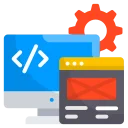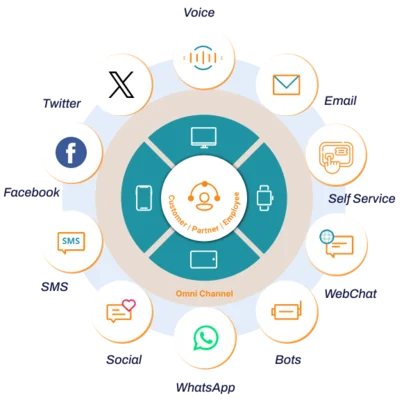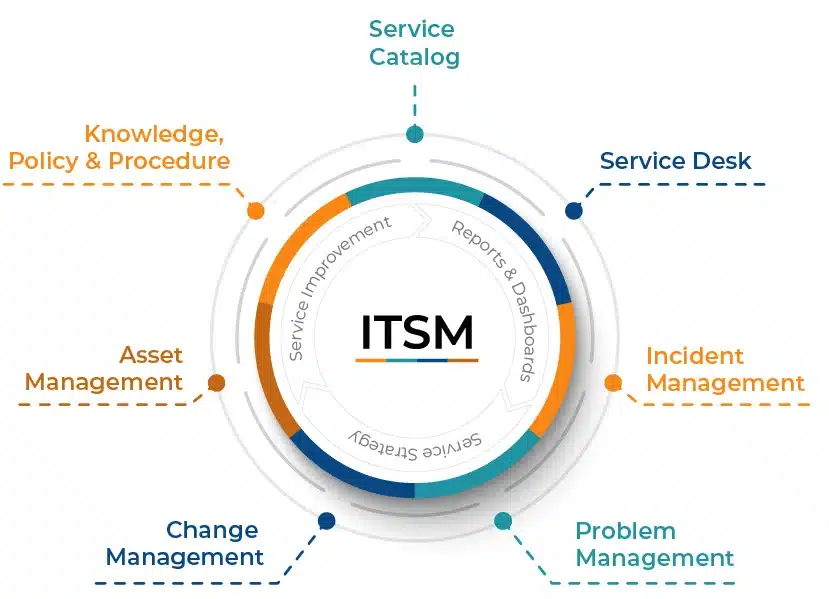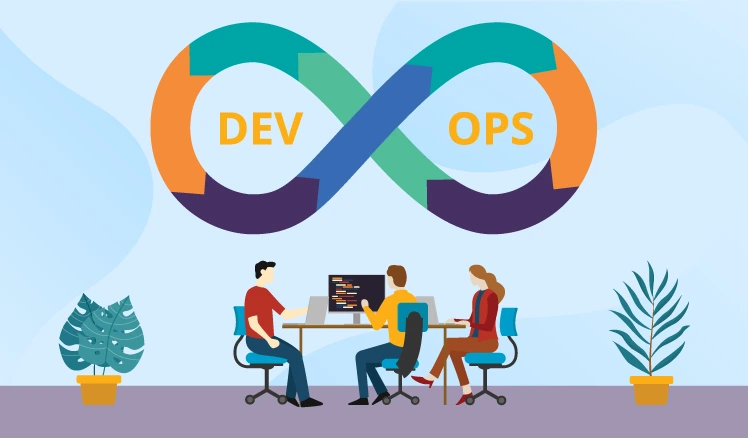Omni-Channel Contact Center + Helpdesk
Empowering Your Business with Innovative Solutions
Elevate customer engagement and streamline IT services with our transformative Omni-Channel Contact Center and Helpdesk/ITSM solutions.

Comprehensive Services
Complete Solution Partner Transforming Possibilities

Custom Software Development
Innovate with our Custom Software Development solutions. Tailored software to streamline operations and drive business growth.

Web Development, Hosting & Maintenance
Empower your online presence with our end-to-end Managed Web Development, Hosting, and Maintenance services. From creation to ongoing support, we’ve got you covered.

Managed Web Application Firewall
Ensure digital security with our Managed Web Application Firewall. Safeguard your applications and protect sensitive data.

Cloud Business Email Services
Elevate communication with our Cloud Business Email services. Secure, scalable, and feature-rich solutions tailored to your organizational needs.

Cloud Migration & Deployment Services
We offer Cloud Migration & Deployment Services designed to streamline your transition, optimize your cloud infrastructure, and help you reap the full benefits of cloud computing.

Managed IT Services
Comprehensive, proactive, and round-the-clock IT support and solutions from network monitoring and security to data backup and IT consulting. Trust us as your IT partner to optimize your technology, enhance security.
Business Clients
Perfectly Aligned with Your Business’s Unique Needs and Goals













Our Leading Products
Revolutionizing Communication and Support

Omnichannel Contact Center
Revolutionize customer interactions with our cutting-edge Omnichannel Contact Center Software. Seamlessly connect with customers across multiple channels for enhanced customer engagement.

ITSM Software
Simplify and optimize your IT service management with our innovative ISTM Software. Streamline processes, enhance efficiency, and ensure seamless IT service delivery.
Business Resources
Valuable business resources from industry leaders
FAQs
1. Custom Software Development: Developing tailor-made software solutions to meet the unique needs and requirements of clients.
2. Web Development: Creating websites, web applications, and e-commerce platforms using various programming languages and frameworks.
3. Mobile App Development: Designing and developing mobile applications for iOS, Android, or cross-platform using technologies like React Native or Flutter.
4. Cloud-Based Solutions: Building cloud-native applications, migrating existing systems to the cloud, and utilizing cloud services like AWS, Azure, or Google Cloud.
5. UI/UX Design: Designing user interfaces (UI) and user experiences (UX) to create user-friendly and visually appealing software.
6. Quality Assurance and Testing: Conducting thorough testing, including manual and automated testing, to ensure software reliability and performance.
7. Enterprise Software Solutions: Developing software for businesses to improve productivity, streamline operations, and manage resources efficiently.
8. Blockchain Development: Building blockchain-based applications and solutions for industries like finance, supply chain, and healthcare.
9. AI and Machine Learning: Implementing artificial intelligence and machine learning algorithms to provide data-driven insights and automation.
10. IoT (Internet of Things) Development: Creating software for IoT devices and platforms, enabling smart and connected solutions.
11. E-commerce Solutions: Developing e-commerce platforms, shopping cart systems, and payment gateways for online businesses.
12. CRM (Customer Relationship Management): Building CRM software to manage and improve customer interactions and relationships.
13. ERP (Enterprise Resource Planning): Developing ERP systems for efficient resource management, including finance, HR, and inventory.
14. Big Data and Analytics: Collecting, processing, and analyzing large volumes of data to extract valuable insights and support decision-making.
15. Cybersecurity Services: Providing security assessments, vulnerability testing, and solutions to protect against cyber threats.
16. Consulting and Strategy: Offering consultancy services to help clients define software strategies, roadmaps, and technology stack choices.
17. Legacy System Modernization: Updating and modernizing outdated software systems to improve performance, security, and functionality.
18. Maintenance and Support: Providing ongoing maintenance, updates, and technical support for software post-launch.
19. DevOps and Continuous Integration/Continuous Deployment (CI/CD): Implementing DevOps practices and automation to streamline development and deployment processes.
20. Training and Documentation: Offering training for clients and end-users and providing comprehensive documentation for software usage.
21. Data Migration and Integration: Assisting with data migration between systems and integrating software with third-party services and APIs.
1. Healthcare: Develop applications for electronic health records (EHR), telemedicine, patient management, medical billing, and more. Compliance with regulations like HIPAA is crucial in this sector.
2. Finance and Fintech: Focus on financial software solutions, including banking applications, payment gateways, trading platforms, and financial analytics tools. Compliance with financial regulations is a key consideration.
3. E-commerce: E-commerce platforms, online marketplaces, and shopping cart systems. They may also work on payment processing and inventory management solutions.
4. Manufacturing and Supply Chain: Build software for inventory management, supply chain optimization, production planning, and quality control.
5. Retail: Work on point-of-sale (POS) systems, inventory management, customer relationship management (CRM), and e-commerce integration.
6. Energy and Utilities: Software for energy management, utility billing, renewable energy monitoring, and grid management systems.
7. Transportation and Logistics: Specialization in transportation and logistics includes developing solutions for route optimization, fleet management, shipment tracking, and warehouse management.
8. Education and EdTech: This specialization involves creating e-learning platforms, learning management systems (LMS), and educational apps for schools, colleges, and online courses.
9. Government and Public Sector: Develop software for government agencies, including solutions for citizen services, tax collection, and public safety.
10. Real Estate: Software development companies in real estate create property management systems, real estate marketplaces, and CRM tools for real estate agents.
11. Hospitality and Tourism: Develop software for hotel management, online booking systems, restaurant reservations, and travel booking platforms.
12. Nonprofits and NGOs: Specialize in creating solutions to support the mission of nonprofits and non-governmental organizations, such as donation platforms and fundraising software.
13. Legal and Compliance: To assist legal professionals with case management, document generation, and compliance tracking.
1. Project Initiation:
◦ Define the project’s goals, objectives, and scope.◦ Identify stakeholders and gather initial requirements.
◦ Conduct a feasibility study to assess the project’s viability.
2. Requirements Gathering and Analysis:
◦ Work closely with stakeholders to gather detailed requirements.
◦ Analyze and document user stories, use cases, and functional requirements.
◦ Prioritize requirements and create a project roadmap.
3.System Design:
◦ Develop a high-level architectural design.
◦ Create detailed technical specifications, including data models, system architecture, and database design.
◦ Plan for scalability, security, and performance.
4. Development:
◦ Write code according to the design and specifications.
◦ Follow coding standards and best practices.
◦ Use version control systems to manage code changes.
5. Testing and Quality Assurance:
◦ Conduct various levels of testing, including unit testing, integration testing, and system testing.
◦ Identify and address defects and bugs.
◦ Ensure the software meets the defined requirements and quality standards.
6. Deployment and Integration:
◦ Deploy the software to staging and production environments.
◦ Integrate the software with third-party systems or services, if necessary.
◦ Monitor and troubleshoot any issues during deployment.
7. User Acceptance Testing (UAT):
◦ Involve users or stakeholders in UAT to validate that the software meets their needs and expectations.
◦ Address any feedback and make necessary adjustments.
8. Documentation:
◦ Create user documentation, including user manuals, help guides, and FAQs.
◦ Develop technical documentation for administrators and developers.
9. Training:
Provide training to end-users, administrators, and support staff on how to use and manage the software effectively.
10. Deployment to Production:
◦ After successful UAT and final approvals, deploy the software to the production environment.
◦ Monitor system performance and stability in the production environment.
11. Maintenance and Support:
◦ Provide ongoing maintenance, updates, and support for the software post-launch.
◦ Address bug fixes, security patches, and feature enhancements as needed.
12. Monitoring and Performance Optimization:
◦ Continuously monitor the software’s performance, scalability, and security.
◦ Optimize the software for improved efficiency and user experience.
13. Feedback and Iteration:
◦ Gather feedback from users and stakeholders to identify areas for improvement.
◦ Plan and prioritize updates and enhancements in subsequent iterations.
14. Project Closure:
◦ Evaluate the project’s success against initial goals and objectives.
◦ Conduct a post-project review to identify lessons learned.
◦ Archive project documentation and code repositories.
Front-end Development:
1. HTML/CSS: These are fundamental technologies for building the structure and styling of web pages.
2. JavaScript: A versatile programming language used for client-side scripting, making web applications interactive and dynamic.
3. React: A popular JavaScript library for building user interfaces, often used for single-page applications (SPAs).
4. Angular: A framework for building dynamic web applications, providing a comprehensive set of tools and features.
5. Vue.js: A progressive JavaScript framework for building user interfaces, known for its simplicity and flexibility.
Back-end Development:
1. Node.js: A runtime environment for executing JavaScript server-side, ideal for building scalable and real-time applications.
2. Python: A versatile language used for web development, data analysis, machine learning, and more.
3. Ruby: Known for its simplicity and elegance, often used with the Ruby on Rails framework for web development.
4. Java: A widely used language for building enterprise-level applications, web services, and Android apps.
5. PHP: Commonly used for web development, particularly with the Laravel or Symfony frameworks.
6. C#: Primarily used for developing Windows applications and web services, often with the ASP.NET framework.
Database Management:
1. MySQL: A popular open-source relational database management system (RDBMS).
2. PostgreSQL: An advanced open-source RDBMS known for its reliability and features.
3. MongoDB: A NoSQL database used for handling large volumes of unstructured data.
4. Redis: An in-memory data store used for caching and real-time data processing.
Mobile App Development:
1. iOS Development (Swift/Objective-C): Swift is the modern language of choice for iOS development, while Objective-C is still used in legacy projects.
2. Android Development (Kotlin/Java): Kotlin has gained popularity as an alternative to Java for Android app development.
Cloud Services and Deployment:
1. Amazon Web Services (AWS): A leading cloud platform offering a wide range of services for hosting and scaling applications.
2. Microsoft Azure: Microsoft’s cloud platform with services for application hosting, AI, and more.
3. Google Cloud Platform (GCP): Google’s cloud services, known for its data analytics and machine learning offerings.
4. Heroku: A cloud platform that simplifies application deployment and management.
DevOps and Containerization:
1. Docker: A platform for containerization, allowing applications to run in isolated environments.
2. Kubernetes: An orchestration platform for managing containerized applications and automating deployment and scaling.
These are just some of the many technologies and programming languages available in the software development landscape. The choice of technology stack depends on the specific project requirements, performance considerations, scalability needs, and the expertise of the development team.
1. Threat Modeling:
◦ Conduct a threat modeling exercise to identify potential security threats, risks, and vulnerabilities in the software’s design and architecture.
2. Security Requirements:
◦ Define security requirements early in the development process. Consider factors such as data encryption, authentication, authorization, and compliance with industry-specific regulations.
3. Secure Coding Practices:
◦ Train developers in secure coding practices to minimize common vulnerabilities, such as SQL injection, cross-site scripting (XSS), and cross-site request forgery (CSRF).
4. Code Review and Static Analysis:
◦ Perform regular code reviews to identify and address security issues. Use automated static analysis tools to scan code for vulnerabilities.
5. Authentication and Authorization:
◦ Implement strong authentication mechanisms, including multi-factor authentication (MFA) where appropriate. Ensure that users have the necessary permissions through proper authorization controls.
6. Data Encryption:
◦ Encrypt sensitive data at rest and in transit using strong encryption algorithms and protocols. Use HTTPS for web applications.
7. Input Validation:
◦ Validate and sanitize all user inputs to prevent malicious input from being processed by the application.
8. Patch Management:
◦ Stay up-to-date with security patches and updates for all software components and dependencies used in the application stack.
9. Session Management:
◦ Implement secure session management to prevent session fixation, session hijacking, and other session-related attacks.
10. Cross-Site Scripting (XSS) Prevention:
◦ Sanitize and escape user-generated content to prevent XSS attacks. Use security headers like Content Security Policy (CSP) to mitigate XSS risks.
11. Cross-Site Request Forgery (CSRF) Protection:
◦ Implement anti-CSRF tokens to protect against CSRF attacks.
12. Security Headers:
◦ Set security headers in HTTP responses to mitigate various types of attacks, such as clickjacking and MIME type sniffing.
13. API Security:
◦ Secure APIs by implementing authentication, authorization, rate limiting, and input validation.
14. Security Testing:
◦ Conduct security testing, including penetration testing and vulnerability scanning, to identify and address security weaknesses.
15. Security Education and Training:
◦ Provide ongoing security training for development and IT teams to keep them informed about the latest security threats and best practices.
16. Incident Response Plan:
◦ Develop an incident response plan to effectively respond to security incidents, including data breaches or cyberattacks.
17. Compliance with Regulations:
◦ Ensure that the software complies with industry-specific regulations (e.g., GDPR, HIPAA, PCI DSS) and follows best practices for data privacy and protection.
18. Third-Party Assessments:
◦ Regularly assess the security of third-party components, libraries, and services used in the software.
19. Security Documentation:
◦ Maintain detailed security documentation, including threat models, security architecture, and security incident records.
20. Continuous Monitoring:
◦ Continuously monitor the software for security threats and vulnerabilities, and respond promptly to emerging issues.
1. Hourly Rate:
◦ In this model, the client is charged an hourly rate for the work performed by the development team. The total cost depends on the number of hours worked. Hourly rates can vary significantly based on the skill level of the team members and the geographic location of the company.
2. Fixed Price (Fixed-Bid):
◦ Under a fixed-price model, the client and we agree on a predetermined price for the entire project. This price is fixed regardless of the actual time and effort required. It’s crucial to have well-defined project requirements for this model to work effectively.
3. Time and Materials (T&M):
◦ In a time and materials model, the client pays for the actual time and materials used during the project. This pricing structure provides flexibility, particularly when project requirements are subject to change.
4. Dedicated Team (Staff Augmentation):
◦ With a dedicated team model, the client hires a dedicated team of developers, designers, and other professionals from us. Clients pay for the team’s salaries and other associated costs.
5. Retainer-Based Pricing:
◦ Clients pay a recurring fee to retain our services on an ongoing basis. This model is suitable for long-term collaborations and maintenance agreements.
6. Outcome-Based Pricing:
◦ In this model, the pricing is based on specific outcomes or deliverables achieved rather than the time spent. This can include milestone-based payments or payment upon achieving predefined project goals.
7. Value-Based Pricing:
◦ The pricing is determined based on the perceived value of the software solution to the client’s business. This approach may consider factors like cost savings, revenue generation, and competitive advantage.
8. Hybrid Models:
◦ Some companies use hybrid pricing models that combine elements of the above approaches to create a customized pricing structure that meets the client’s specific needs.
When determining the appropriate pricing structure, it’s essential to consider factors such as the project’s complexity, expected duration, client preferences, and budget constraints. Additionally, we may provide detailed project proposals and estimates that outline the pricing structure, deliverables, timelines, and payment terms. It’s advisable to discuss pricing and contract terms thoroughly with us to ensure a clear and mutually beneficial agreement.
1. Initial Scope Documentation:
◦ Start by documenting the project’s initial scope, including requirements, features, and objectives. This serves as a baseline for the project.
2. Change Request Process:
◦ Implement a formal change request process. Require clients to submit change requests in writing, outlining the proposed changes and the reasons for them.
3. Scope Change Evaluation:
◦ Review each change request carefully. Assess its impact on the project’s timeline, budget, and resources. Consider the feasibility of the proposed changes.
4. Prioritization and Impact Analysis:
◦ Prioritize scope changes based on their importance and impact on project goals. Collaborate with the client to understand the business value of each change.
5. Estimation and Cost Assessment:
◦ Provide the client with an estimate of the additional time, effort, and cost required to implement the scope change. Be transparent about the implications of the change.
6. Client Approval:
◦ Seek formal approval from the client for the scope change, including agreement on any adjustments to the project timeline or budget.
7. Documentation and Communication:
◦ Document all approved scope changes and communicate them to the project team. Ensure that everyone is aware of the modifications.
8. Adjust Project Plan:
◦ Update the project plan, including timelines, milestones, and deliverables, to reflect the approved scope changes.
9. Resource Allocation:
◦ Reallocate resources as needed to accommodate the scope changes. This may involve shifting team members or adjusting workloads.
10. Regular Reporting:
◦ Maintain open and transparent communication with the client throughout the project. Provide regular status reports that include information on scope changes and their impact.
11. Change Control Board (CCB):
◦ Establish a Change Control Board or committee that includes key project stakeholders. This group can review and approve or reject scope changes based on their impact and alignment with project goals.
12. Risk Assessment:
◦ Evaluate the risks associated with each scope change, including potential delays, increased costs, and impact on the overall project.
13. Documentation Traceability:
◦ Ensure that all changes, approvals, and related documentation are traceable and well-documented for auditing and reporting purposes.
14. Prevent Scope Creep:
◦ Proactively manage scope changes to prevent scope creep, which is the uncontrolled expansion of project scope. Educate clients about the importance of maintaining project focus.
15. Change Freeze Periods:
◦ Consider implementing change freeze periods during critical project phases to minimize disruption caused by frequent scope changes.
16. Continuous Monitoring:
◦ Continuously monitor the project’s progress and client feedback. Be prepared to make adjustments if new scope changes become necessary.
17. Conflict Resolution:
◦ In case of disagreements or disputes over scope changes, follow a defined dispute resolution process that may involve senior management or contractual mechanisms.
Effective scope change management is crucial for maintaining project quality, meeting deadlines, and managing client expectations. It’s important to strike a balance between accommodating client needs and maintaining project control to ensure a successful outcome.
Reach Out for Assistance. We’re Here to Help.
Support Email
talk to our agent




